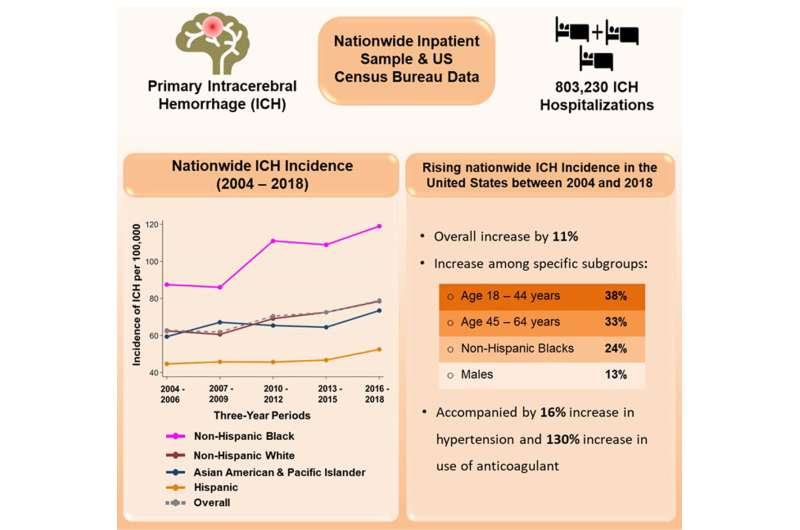Deadly type of stroke increasing among younger and middle-aged adults

New cases of a debilitating and often deadly type of stroke that causes bleeding in the brain have been increasing in the U.S., growing at an even faster rate among younger to middle-aged adults than older ones, new research shows.
The findings show an 11 percent increase over the past decade and a half in intracerebral hemorrhage strokes, referred to as ICH strokes. The research, being presented next week at the American Stroke Association's International Stroke Conference, was published Thursday in the American Heart Association journal Stroke.
"From a public health perspective, these results are troubling and indicate risk factors are not being well managed in young adults in the U.S.," said Dr. Karen Furie, chief of neurology at Rhode Island Hospital and chair of the department of neurology at Brown University's Warren Alpert Medical School in Providence. Furie was not involved in the research.
"Earlier onset of this disease is very alarming and indicates we need to be more aggressive with primary prevention," she said.
ICH strokes occur when blood vessels in the brain rupture and bleed. They are the second most common type, accounting for 10–15 percent of the estimated 795,000 strokes each year in the U.S. Globally in 2020, 18.9 million people had an intracerebral hemorrhage, according to the AHA's most recent heart and stroke statistics report. They are more deadly and more likely to cause long-term disability than other types of stroke.
Smaller previous studies have reached conflicting conclusions about whether the rate of ICH has been rising or falling in the U.S.
In the new study, lead researcher Abdulaziz Bako, a postdoctoral fellow at Houston Methodist Hospital, and colleagues used aggregated nationwide data from 803,230 ICH hospitalizations. They calculated the rate of ICH over five consecutive three-year periods from 2004 to 2018. People were divided into four age groups: 18–44 years; 45–64 years; 65–74 years; and 75 years and older.
Overall, researchers found an 11 percent increase in the rate of ICH among U.S. adults over the 15-year study period. ICH increased at a faster rate for adults under age 65 compared to those 75 and older. The rate of increase also varied by region, climbing faster in the South, West and Midwest than it did in the Northeast. ICH stroke rates were 43 percent higher for men than women.
Among those who had ICH strokes, the percentage of people who had high blood pressure also rose, from 74.5 percent to 86.4 percent over the study period.
High blood pressure is a major risk factor for an ICH stroke, as is increasing age. The findings are alarming, Furie said, because they suggest blood pressure is so poorly controlled among younger adults that they risk losing the most productive years of their lives.
"ICH occurs after decades of vascular damage from unmanaged high blood pressure," she said. "It's terrible that this is occurring."
Failure to reverse the trend "could be devastating," Furie said. "We're talking about decades of disability that could be a burden for the individual, their family and society as a whole."
Bako said that's why future studies should really focus on these young age groups, "particularly because they are more likely to be economically productive, and an increase among this population in the long term might lead to much more burden to the comorbidity profile of the country than if the increase were among people who are much older."
Bako is part of a team also presenting findings at the stroke conference from a related study that found a disproportionate rate of ICH among Asian American and Pacific Islander adults, who are experiencing ICH strokes at a younger age than their white peers.
"We need to be teaching people to adopt a healthy diet, engage in regular physical activity, avoid heavy alcohol and drug use and monitor for vascular risk factors during young adulthood," Furie said. "This is the only way to ensure the problem does not become symptomatic by the time they reach their 40s and 50s."
More information: Abdulaziz T. Bako et al, Contemporary Trends in the Nationwide Incidence of Primary Intracerebral Hemorrhage, Stroke (2022). DOI: 10.1161/STROKEAHA.121.037332





















